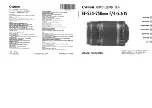
Models LB480A/LB680A
USB Powe™
Product Manual PPA (Pulse Profiling Application)
Revision: 08/02/11
34
Rise Time
Returns the time required for the signal to rise from the 10% level to 90% level. The left gate determines the start of
data. The right gate marks the highest point to be considered. The resultant measurement is the time required to
increase in amplitude from 10% to 90% of the amplitude defined by the right-most gate.
Fall Time
Returns the time required for the signal to decrease from a 90% level to a 10% level as defined by the placement of
the left-most gate. The right gate defines the end of data for this measurement.
Pulse Width
Returns the width of the pulse. The width of the pulse is the time for a signal to rise to within 3 dB of the top of the
pulse then fall 3 dB below the top of the pulse. The left-most gate defines the start of data and the right-most gate
defines the end of data. The gates must be positioned as described below:
o
The left-most gate must follow a positive going edge
o
The right-most gate must be preceded by one or more subsequent falling edges
The measurement first finds the first rising edge. The measurement then finds the first falling edge following the rising
edge. The measurement then determines the time between the first rising edge and the subsequent falling edge. All
other data is ignored.
Pulse Repetition Time and Pulse Repetition Time
PRF and PRT are the inverse or reciprocal of one another. Taking the reciprocal then of PRT is sufficient for
determining PRF. PRT starts much like the pulse width measurement by searching for a rising edge except that the
gates for a PRF (and PRT) measurement must include at least one complete, uninterrupted cycle. Therefore:
o
The left-most gate must follow a positive going edge
o
The right-most gate must follow one or more subsequent falling edges and at least one rising edge
Specifically, if the left-most gate intersects the top of a pulse, the data used to make the measurement will commence
with the subsequent rising edge. The PRT is the time between the first rising edge and the second rising edge.
Duty Cycle
This measurement returns the percentage of on time during a selected cycle. The gates for a duty cycle measurement
must be positioned with exactly the same restrictions as the PRT and PRF measurements. The measurement then
proceeds
to sort all samples into one of two bins. One bin is the “ON” bin and the other bin is the “OFF” bin. All points
within 3 dB of the puls
e top are placed in the “ON” bin. All other samples are placed in the “OFF” bin. Then a simple
calculation is done:
DC (Duty Cycle) = #ON samples / (#ON s #OFF samples)
Pulse Power
This measurement reports the average power of all samples between the rising and falling edges. In this case the gate
must be positioned exactly like Pulse Width measurements. The average of all samples between the rising and falling
edges is reported.
Peak Power
This measurement reports the highest power level between two gates. There is no requirement for a rising or falling
edge anywhere within the measurement window as defined by the gates.
Average Power
This measurement reports the average of all power between two gates. There is no requirement for a rising or falling
















































